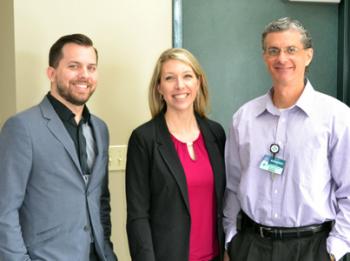
Destin Ortego, project coordinator for Opportunity Machine, a business acceleration and incubation center, explains the use of social media to a number of local and area business people Thursday morning at The Green Room in Rayne. The presentation was sponsored by Acadia General Hospital and hosted by OneAcadia.

Conducting the inaugural OneResource session Thursday morning in The Green Room in Rayne were, from left, Destin Ortego, project coordinator, Opportunity Machine in Lafayette; Laurie Suire, president and CEO of OneAcadia, hosts; and Raymond Rupert of Acadia General Hospital, sponsors.
Social media touted
Steve Bandy
LSN Staff Writer
Facebook can be more than a site on which to follow what your friends are having for lunch, or what your kids, and/or grandkids, are up to these days.
The popular social media site can be used — and is being used — as a valuable advertising platform for business.
Destin Ortego, project coordinator for Opportunity Machine, a Lafayette-based entrepreneurial acceleration and incubation center, explained the strategy behind that concept to a capacity crowd in The Green Room in Rayne Thursday morning.
The presentation was the inaugural session of what is planned as a monthly series hosted by OneAcadia, the parishwide business coalition. Thursday’s “OneResource” session was sponsored by Acadia General Hospital.
Ortego’s two-hour presentation ran the gamut from explaining what is most effective on Facebook to the construction and placement of advertising.
How has Facebook become such an important tool in business? The ability to interact, according to Ortego.
“People want to share their opinions. The want to ask questions,” he said.
Ortego pointed out that 90 percent of information transmitted to the brain is visual, as opposed to reading text.
“Photos outperform text, videos and links for the number of likes, comments and shares on Facebook,” he said.
But don’t underestimated the power of videos.
Eighty-five percent of the U.S. population watches internet videos, most between the ages of 25 and 34. And males spend 40 percent more time watching videos than do women.
“Viewers are 85 percent more likely to purchase a product or take action after watching a short product video or a video with a call to action (sign up, order),” Ortego said, adding that videos should be kept to 3 minutes or less.
Also important to remember is KISS — keep it super simple.
Before turning to the paid advertisements, Ortego touched on the use of free posts on Facebook, explaining a number of interesting facts.
For example, a post remains active — “engaged” — for about five hours.
Also, posts see 11 percent more engagement between 5 p.m. and 1 a.m.
“That’s because most people are at work until 5,” he said. “While a lot of people are ‘surfing’ the internet during business hours, they don’t want their bosses to know, so they don’t ‘engage’ the site.”
He said posts on Sunday’s generally get 25 percent more likes, shares and comments than those during the week — and posts on Tuesday through Thursday are the “weakest.”
Concerning paid advertising on the social media site, Ortego outlined a number of considerations, including photo quality and selection, use of text, market targeting and payment.
Ortego fielded a number of questions from audience members and invited everyone to learn more about the advantages of social media at www.opportunitymachine.org.
- Log in to post comments
